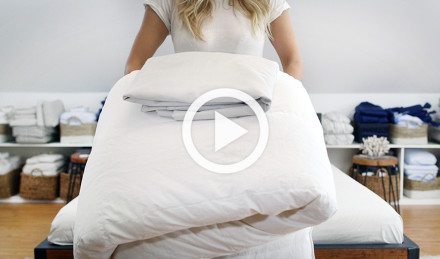Becoming a parent can be one of the most exhilarating experiences in your life. But the moment you bring home your bundle of joy, you also realize that your life will never be the same. Taking care of a baby can be overwhelming, especially in the first three to six months. That’s when your schedule shifts to revolve entirely around your little one’s sleeping and eating habits.
And newborns have unique sleep schedules. While it’s important to remember that there is no one-size-fits-all approach, there are still specific guidelines you should be aware of, so you can understand and respond better to your baby’s sleeping needs.
About one in five infants experience sleep issues in the first 36 months of their life[1]. As a parent, you need to learn to recognize these issues early on, to reduce the likelihood that you’re baby will develop permanent sleeping problems. Some newborn sleep symptoms can also indicate other health issues, which is another reason to know what constitutes normal infant sleeping patterns.
Read on for a handy breakdown of all sleep-related baby questions — from how many hours newborns sleep to how long it will be before your newborn sleeps through the night.
Newborn Sleep Patterns
Newborn Sleep Patterns
Your baby is unique, and so is their internal “sleepy time” clock. Still, there are certain commonalities that most newborn sleep schedules share.
How Much Do Newborns Sleep?
Newborns sleep a lot. And that’s absolutely normal. Newborns can spend between 16 to 20 hours sleeping every day[2], waking up only for feedings and staying awake for a couple of hours before dozing off again. They eat so often because their stomachs are tiny. Newborns can’t tell the difference between day and night as they lack an established circadian rhythm.
As newborns transition to infants (between 10-12 weeks), they continue to sleep for about 16-17 hours a day[3]. During this time however, you will notice that your baby starts sleeping a bit more throughout the night.
And speaking of sleeping through the night, studies show that almost a third of children experience night awakenings during their first two years of life[4]. So while most babies will settle into a long, uninterrupted night sleep cycle at about six months of age[5], if your little one doesn’t fall into this category, don’t worry. Their sleep will normalize eventually, so be patient.
How Long Do Newborns Sleep?
The duration of your baby’s sleep depends on the kind of food you give them. Breastfed babies generally wake up more often, because breastmilk is easier to digest. Formula may keep your baby full longer, resulting in longer sleep. Newborns can spend anywhere between two and four hours asleep at a stretch, but experts recommend not letting your newborn sleep for more than five hours at a time for safety[6]. You should wake your baby to feed them, and to track their weight gain. Newborns should be fed about 8–12 times a day. A crying baby is usually a hungry baby, but experts don’t recommend waiting until your little one wakes up crying to show that they need to be fed[7].
Of course you also need to know how to properly wake up a baby. Pick them up and start gently moving their legs and arms or tickle the bottom of their feet. If you’re worried that your newborn is sleeping too much or you are unable to wake them up, talk to their pediatrician immediately.
Tips to Help Your Baby Sleep Better
One way to improve your newborn baby’s sleep is to create a bedtime routine. Again, it’s very important to remember that what may work for a friend’s baby might not work for yours. So give yourself — and your little one — some time to experiment.
By keeping a consistent bedtime routine, you can train your baby’s natural biological patterns. This can increase the duration of self-regulated sleep. If getting your baby to sleep at night is a struggle, try shorter naps during the day or a later bedtime. Sticking to time cues can also keep a baby's circadian rhythms in sinc: sunlight in the morning, naps during the day with plenty of light and lots of mental and physical stimulation during the day. A bedtime routine should always include feeding, a bath and a bedtime story. After you are done, put your little one in a crib in a dark and quiet room.
Studies show that swaddled babies sleep longer and are less likely to wake up unexpectedly. Swaddling is when you wrap your baby’s body snugly with a small sheet, blanket or cloth so they can’t move their arms (but can move their hips and legs). Always place a swaddled baby on their back, and make sure your swaddling technique is correct[8].
Learn to read your baby’s signals. For example, place them in their crib when they are drowsy but not yet asleep so they can learn to fall asleep on their own. Another way to get a newborn to sleep at night is to offer them a pacifier. It may help soothe them so they fall asleep faster.
Tips to Help Your Baby Sleep Better
One way to improve your newborn baby’s sleep is to create a bedtime routine. Again, it’s very important to remember that what may work for a friend’s baby might not work for yours. So give yourself — and your little one — some time to experiment.
By keeping a consistent bedtime routine, you can train your baby’s natural biological patterns. This can increase the duration of self-regulated sleep. If getting your baby to sleep at night is a struggle, try shorter naps during the day or a later bedtime. Sticking to time cues can also keep a baby's circadian rhythms in sinc: sunlight in the morning, naps during the day with plenty of light and lots of mental and physical stimulation during the day. A bedtime routine should always include feeding, a bath and a bedtime story. After you are done, put your little one in a crib in a dark and quiet room.
Studies show that swaddled babies sleep longer and are less likely to wake up unexpectedly. Swaddling is when you wrap your baby’s body snugly with a small sheet, blanket or cloth so they can’t move their arms (but can move their hips and legs). Always place a swaddled baby on their back, and make sure your swaddling technique is correct[8].
Learn to read your baby’s signals. For example, place them in their crib when they are drowsy but not yet asleep so they can learn to fall asleep on their own. Another way to get a newborn to sleep at night is to offer them a pacifier. It may help soothe them so they fall asleep faster.
How to Stop Your Baby’s Bad Sleeping Habits
How to Stop Your Baby’s Bad Sleeping Habits
There are a few things to look out for in your baby’s sleep patterns that may worsen with time. Try to catch these early on.
Can Your Newborn Sleep in Your Bed?
In their recommendations on how to keep your sleeping baby safe, the American Academy of Pediatrics (AAP) suggests bringing your baby in your bed only to feed or comfort them. Take your baby back to their crib as soon as they are ready to sleep. The AAP recommends against bed-sharing for safety reasons. You should, however, practice room-sharing until your baby is 12 months old.
Rocking Your Baby
Parents know that rocking works like a charm when it’s time to put a baby to sleep. It’s a fool-proof technique that we even use as adults (have you noticed how easy it is to fall asleep in a hammock?). That’s because rocking has a synchronizing effect on the brain[9] that triggers our natural sleep rhythms.
However, if you rock your baby to sleep every day, you’ll discourage them from learning to soothe themselves and fall asleep on their own. They may become dependent on the rocking, and struggle to doze off when you’re not around. The solution is to rock your baby until they’re sleepy, but then place them in their crib to let them fall asleep on their own.
When to Call Your Doctor
If your baby continually sleeps for more than five hours and is not gaining body weight, consult with your doctor immediately. If you notice that your baby snores loudly or experiences long pauses in breathing while sleeping, this is also something that you need to bring to your pediatrician’s attention.
Must-Have Baby Items That Will Improve Their Sleep
Must-Have Baby Items That Will Improve Their Sleep
Creating a safe and soothing environment for your baby will help them fall asleep faster and for longer. Here’s everything you need to make that happen.
Comfy Crib Mattress
If your baby is less than a year old, what they need in the crib is a firm, no drop-sides mattress and a fitted sheet. Soft surfaces or soft mattresses may create a pocket around your baby and increase the chance of suffocation. Always make sure there are no gaps between the mattress and the sides of the crib.
Luxury Baby Bedding
Baby bed sheets should fit very snuggly to the mattress and will preferably be made from natural cotton or linen. Your baby’s skin is very sensitive, so avoid any bed sheets manufactured with toxic chemicals or synthetic dyes as they may lead to dermatological or respiratory issues.
One helpful way to authenticate that your baby’s bed sheets (and your own bedding) are non-toxic is to check if they’re Oeko-Tex certified. Products will only receive this prestigious certification if they’re made ethically and sustainably, without toxic chemicals.
Can’t decide which bed sheet material to go with for your newborn? Check out this Bedding Fabric & Materials guide for more information.
Swaddle Cloths and Blankets
Swaddle cloths are usually square in size and are made from breathable cotton. If you’re not a pro at swaddling, you can also purchase several ready-to-use swaddles and see which one works best for your baby.
Toddler Pillows and Blankets
Before introducing a toddler pillow and baby blanket into your child’s crib, make sure they are at least 12 months old. Before that, you should only use one as a nursing cover, as a diaper-changing surface or to keep them warm in the stroller.
Wait until your child is at least two years old before letting them sleep on a pillow through the night. You can use pillows for decoration in their room, but never leave a pillow in your child’s crib while they are sleeping in it.
For more details on when your baby can sleep with a pillow and blanket, read our guide, Baby Pillows and Blankets: When Can Newborns Sleep with a Pillow and Blanket?
Where to Shop for High-Quality Baby Bedding
The products you buy for your child’s crib can affect your baby’s health, so invest only in the best and safest items.
The baby bedding line offered by Parachute is made from high-quality materials such as linen and cotton that are never treated with toxic chemicals.
You’ll find a selection of fitted crib sheets made from percale, linen and brushed cotton that are Oeko-Tex Standard 100-certified. Opt for a Waffle Baby Blanket made from pure cotton or a luxury Cashmere Baby Blanket to keep your little one warm while in the car or strolling in the park.
Looking for a blanket for baby’s waking hours? A beautiful Toddler Linen Quilt will come in handy during tummy time or when you need a soft surface to change your baby’s diaper. It comes in four neutral shades and a medium weight that’s perfect for layering. A double-layer Muslin Swaddle Blanket is the perfect swaddle during walks or any time you need a nursing cover.
Read on:
When Should Your Baby Make the Transition From Crib to Toddler Bed?
What is a Toddler Hooded Towel? Everything You Need to Know
Baby Bath Guide: How to Bathe Your Newborn Baby
Welcoming a Baby and New Parents Home
Linen Gift Ideas for Baby Showers & Other Special Occasions
Linen: Know Your Bedding Like a Designer
Sateen: Know Your Bedding Like a Designer
Percale: Know Your Bedding Like a Designer
Brushed Cotton: Know Your Bedding Like a Designer
[1] https://www.ncbi.nlm.nih.gov/pmc/articles/PMC3357046/
[2] https://www.stanfordchildrens.org/en/topic/default?id=newborn-sleep-patterns-90-P02632
[3] https://www.ncbi.nlm.nih.gov/pmc/articles/PMC5440010/
[4] https://www.researchgate.net/profile/Nancy-Nicolson/publication/19209854_SleepWake_Patterns_of_Breast-Fed_Infants_in_the_First_2_Years_of_Life/links/09e41500e8b6c56a43000000/Sleep-Wake-Patterns-of-Breast-Fed-Infants-in-the-First-2-Years-of-Life.pdf
[5] https://www.ncbi.nlm.nih.gov/pmc/articles/PMC5440010/#b8-nss-9-135
[6] https://my.clevelandclinic.org/health/articles/14300-sleep-in-your-babys-first-year
Where to Shop for High-Quality Baby Bedding
The products you buy for your child’s crib can affect your baby’s health, so invest only in the best and safest items.
The baby bedding line offered by Parachute is made from high-quality materials such as linen and cotton that are never treated with toxic chemicals.
You’ll find a selection of fitted crib sheets made from percale, linen and brushed cotton that are Oeko-Tex Standard 100-certified. Opt for a Waffle Baby Blanket made from pure cotton or a luxury Cashmere Baby Blanket to keep your little one warm while in the car or strolling in the park.
Looking for a blanket for baby’s waking hours? A beautiful Toddler Linen Quilt will come in handy during tummy time or when you need a soft surface to change your baby’s diaper. It comes in four neutral shades and a medium weight that’s perfect for layering. A double-layer Muslin Swaddle Blanket is the perfect swaddle during walks or any time you need a nursing cover.
Read on:
When Should Your Baby Make the Transition From Crib to Toddler Bed?
What is a Toddler Hooded Towel? Everything You Need to Know
Baby Bath Guide: How to Bathe Your Newborn Baby
Welcoming a Baby and New Parents Home
Linen Gift Ideas for Baby Showers & Other Special Occasions
Linen: Know Your Bedding Like a Designer
Sateen: Know Your Bedding Like a Designer
Percale: Know Your Bedding Like a Designer
Brushed Cotton: Know Your Bedding Like a Designer
[1] https://www.ncbi.nlm.nih.gov/pmc/articles/PMC3357046/
[2] https://www.stanfordchildrens.org/en/topic/default?id=newborn-sleep-patterns-90-P02632
[3] https://www.ncbi.nlm.nih.gov/pmc/articles/PMC5440010/
[4] https://www.researchgate.net/profile/Nancy-Nicolson/publication/19209854_SleepWake_Patterns_of_Breast-Fed_Infants_in_the_First_2_Years_of_Life/links/09e41500e8b6c56a43000000/Sleep-Wake-Patterns-of-Breast-Fed-Infants-in-the-First-2-Years-of-Life.pdf
[5] https://www.ncbi.nlm.nih.gov/pmc/articles/PMC5440010/#b8-nss-9-135
[6] https://my.clevelandclinic.org/health/articles/14300-sleep-in-your-babys-first-year









